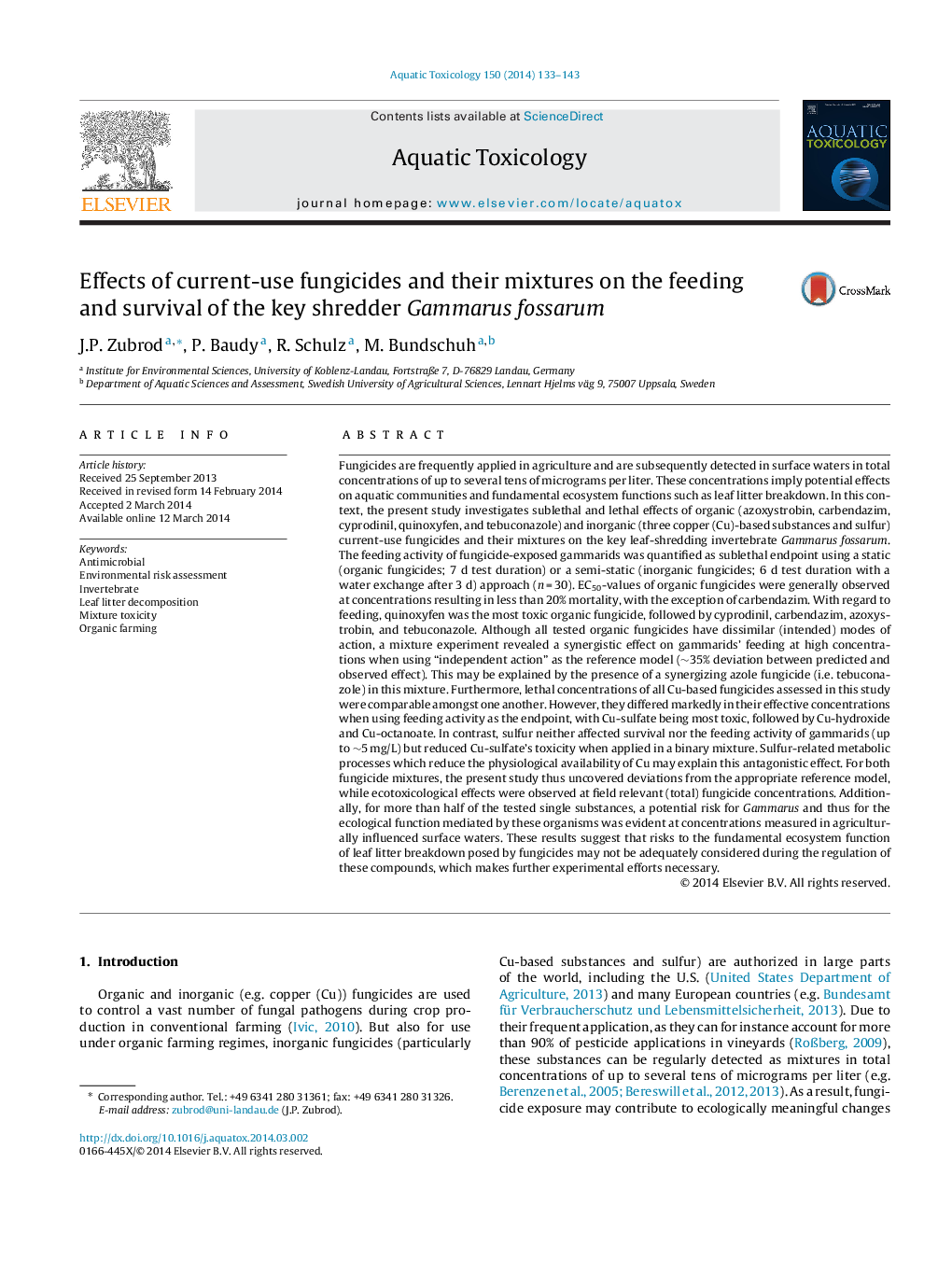| کد مقاله | کد نشریه | سال انتشار | مقاله انگلیسی | نسخه تمام متن |
|---|---|---|---|---|
| 4529275 | 1625955 | 2014 | 11 صفحه PDF | دانلود رایگان |

• Fungicides pose a risk for Gammarus at environmentally relevant concentrations.
• Mixture of the tested organic fungicides produced slightly synergistic effect.
• Elemental sulfur acted antagonistically on copper's toxicity.
• Fungicides used in organic farming may adversely affect aquatic invertebrates.
Fungicides are frequently applied in agriculture and are subsequently detected in surface waters in total concentrations of up to several tens of micrograms per liter. These concentrations imply potential effects on aquatic communities and fundamental ecosystem functions such as leaf litter breakdown. In this context, the present study investigates sublethal and lethal effects of organic (azoxystrobin, carbendazim, cyprodinil, quinoxyfen, and tebuconazole) and inorganic (three copper (Cu)-based substances and sulfur) current-use fungicides and their mixtures on the key leaf-shredding invertebrate Gammarus fossarum. The feeding activity of fungicide-exposed gammarids was quantified as sublethal endpoint using a static (organic fungicides; 7 d test duration) or a semi-static (inorganic fungicides; 6 d test duration with a water exchange after 3 d) approach (n = 30). EC50-values of organic fungicides were generally observed at concentrations resulting in less than 20% mortality, with the exception of carbendazim. With regard to feeding, quinoxyfen was the most toxic organic fungicide, followed by cyprodinil, carbendazim, azoxystrobin, and tebuconazole. Although all tested organic fungicides have dissimilar (intended) modes of action, a mixture experiment revealed a synergistic effect on gammarids’ feeding at high concentrations when using “independent action” as the reference model (∼35% deviation between predicted and observed effect). This may be explained by the presence of a synergizing azole fungicide (i.e. tebuconazole) in this mixture. Furthermore, lethal concentrations of all Cu-based fungicides assessed in this study were comparable amongst one another. However, they differed markedly in their effective concentrations when using feeding activity as the endpoint, with Cu-sulfate being most toxic, followed by Cu-hydroxide and Cu-octanoate. In contrast, sulfur neither affected survival nor the feeding activity of gammarids (up to ∼5 mg/L) but reduced Cu-sulfate's toxicity when applied in a binary mixture. Sulfur-related metabolic processes which reduce the physiological availability of Cu may explain this antagonistic effect. For both fungicide mixtures, the present study thus uncovered deviations from the appropriate reference model, while ecotoxicological effects were observed at field relevant (total) fungicide concentrations. Additionally, for more than half of the tested single substances, a potential risk for Gammarus and thus for the ecological function mediated by these organisms was evident at concentrations measured in agriculturally influenced surface waters. These results suggest that risks to the fundamental ecosystem function of leaf litter breakdown posed by fungicides may not be adequately considered during the regulation of these compounds, which makes further experimental efforts necessary.
Journal: Aquatic Toxicology - Volume 150, May 2014, Pages 133–143